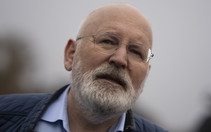
"Ein Leben": nel secondo libro-intervista di Benedetto XVI un'altra storia sulle sue dimissioni
Proviamo a leggere come se fosse vera l'ipotesi dell'avv. Acosta e vediamo se fila

(ENGLISH VERSION BELOW)
Qualche giorno fa, ci eravamo accorti di strane incongruenze e della possibilità di uno scioccante sottotesto nel libro intervista di Peter Seewald - Benedetto XVI “Ultime conversazioni” (Garzanti 2016) QUI .
A una lettura più approfondita, lo scritto è parso poter collimare con uno scenario tratteggiato ormai da vari teologi, giornalisti, latinisti ed esplicitato giuridicamente dal recente volume “Benedict XVI: pope emeritus?” dell’avvocatessa Estefania Acosta QUI .
Secondo tale tesi, Benedetto XVI, ormai assediato dalla fronda modernista interna e da poteri mondialisti esterni, nel 2013 non ha mai lasciato il soglio petrino: ha solo annunciato dimissioni dall’esercizio delle sue funzioni, per giunta senza mai ratificarle. QUI
In tal modo avrebbe consentito che i suoi nemici si impadronissero del potere costituendo, di fatto un antipapato. Perché tutto questo? Si tratterebbe di una ritirata strategica per consentire a forze anticristiche di manifestarsi e di essere poi annullate, grazie al riconoscimento dell’unico vero papa, Benedetto, per una redenzione-purificazione della Chiesa. Negli ultimi otto anni, Ratzinger, tenuto sotto controllo dal potere antipapale, ci ha così inviato continui messaggi attraverso un linguaggio sottilmente logico per facilitare la nostra presa di coscienza.
La questione, per quanto incredibile possa apparire, è seria e ci sono perfino sacerdoti che si fanno scomunicare per la loro fedeltà a papa Benedetto. L’ultimo è don Enrico Bernasconi, di cui vi proponiamo un’intervista QUI .
Siamo così andati a leggere anche il secondo libro di Peter Seewald “Ein Leben – Una vita” del 2020 (Garzanti), di cui sulla stampa sono filtrati pochi e disorganizzati frammenti.
La voluminosa biografia contiene otto pagine con nuove domande a Ratzinger. Proviamo a leggerle secondo l’ottica di cui sopra e vediamo se il senso può filare.
Innanzitutto, dichiara Ratzinger: “La mia intenzione non era semplicemente e primariamente fare pulizia nel piccolo mondo della Curia, bensì nella Chiesa nel suo insieme”. E Poi: “La vera minaccia per la Chiesa viene dalla dittatura universale di ideologie apparentemente umanistiche, contraddire le quali comporta l’esclusione dal consenso di base della società. […] La società moderna intende formulare un credo anticristiano: chi lo contesta viene punito con la scomunica sociale. Avere paura di questo potere spirituale dell’Anticristo è fin troppo naturale”.
E fin qui ci saremmo. Benedetto subito dopo, sottolinea le differenze con un suo illustre predecessore.
“La visita (2009) alla tomba di papa Celestino V fu in realtà un evento casuale; in ogni caso ero ben consapevole del fatto che la situazione di Celestino V era estremamente peculiare e che quindi non poteva in alcun modo essere invocata come (mio) precedente”.
(Si potrebbe leggere: “Celestino V si dimise legalmente nel 1294 perché non se la sentiva di assumersi l’onere del papato, cosa che io non ho assolutamente fatto, dato che non mi sono dimesso da papa, ma ho solo dichiarato di voler rinunciare all’esercizio del potere pratico, per gli scopi che sappiamo. Io e Celestino non abbiamo nulla in comune”).
Prosegue il Santo Padre:
“Non era assolutamente mia intenzione effettuare «una presa di distanza estrema dalle condizioni in cui versa la Chiesa». Se si studia la storia dei papi, ci si accorgerà ben presto che la Chiesa è sempre stata una rete in cui finiscono pesci buoni e pesci cattivi. La concezione cattolica della Chiesa e dei ruoli dirigenziali al suo interno esclude che si adotti come parametro quello di una Chiesa ideale e prevede invece che si sia pronti a vivere e a lavorare in una Chiesa assediata dalle forze del male”.
(Volendo: “Non ho minimamente abbandonato il ruolo di papa. Si sa che la storia della Chiesa è piena di antipapi e bisogna essere pronti a fare fronte all’assedio delle forze del male”).
Seewald affronta poi la questione chiave: secondo gli storici della Chiesa non esiste un papa «emerito», poiché non ci possono essere due papi. E’ pur vero che, dagli anni ’70, un vescovo può dimettersi e diventare emerito, ma questo – chiede - vale anche per il papa?
Risponde Ratzinger: “Non si capisce perché questa figura giuridica non debba essere applicata anche al vescovo di Roma. La formula riesce a rendere conto di entrambi gli aspetti: da un lato nessun mandato giuridico concreto, dall’altro un incarico spirituale che si mantiene, seppure invisibile. Proprio la figura giuridica e spirituale dell’emerito consente di scongiurare anche solo l’idea della convivenza di due papi, dato che una sede vescovile può avere un solo detentore”.
C’è un solo papa dunque. Ma quando dice “la figura giuridica e spirituale dell’emerito”, a quale dei due si riferisce, al papa o al vescovo? L’ambiguità non sembra casuale, ma spiega il latinista Frà Alexis Bugnolo, esperto di diritto canonico:
“Se intendiamo VESCOVO emerito, l’argomento è invalido dal punto di vista canonico perché un vescovo riceve un ufficio ecclesiastico e, visto che il suo mandato come vescovo ordinario è stato creato dalla Chiesa, si possono permettere due persone nella dignità vescovile. Se intendiamo PAPA emerito, l’argomento è ancora invalido dato che non esiste una figura giuridica di papa emerito e visto che il munus non è condivisibile iure divino”.
Anche per il teologo Carlo Maria Pace, che QUI ha analizzato l'invalidità delle dimissioni di Ratzinger per il loro differimento, conferma: "Benedetto XVI ha affermato erroneamente che un Papa che si dimette rimane Papa allo stesso modo che i vescovi che si dimettono rimangono vescovi".
In sostanza, il papa emerito sarebbe egli stesso IL papa. Infatti, se UN vescovo dimettendosi (dalla carica di origine umana) può diventare UN vescovo emerito, IL papa, rinunciando al ministerium resta sempre IL papa, anche se emerito, poiché mantiene il munus che è dato direttamente da Dio. Ecco perché Ratzinger continua a dire da otto anni che il papa è solo uno e non specifica mai che è Francesco.
Benedetto sembra ribadire il concetto, poche righe dopo, con un esempio: “Un padre resta tale fino alla morte (anche se passa l’amministrazione dell’azienda al figlio) e il significato umano e spirituale dell’essere padre non è revocabile”.
Ma quale sarebbe lo scopo spirituale di queste finte dimissioni?
Una spiegazione è offerta dalla domanda stessa di Seewald:
“Il filosofo italiano Giorgio Agamben si dice convinto del fatto che la vera ragione delle sue dimissioni sia stata la volontà di risvegliare la coscienza escatologica (riguardante i destini ultimi dell'uomo n.d.r.). Nel piano divino della salvezza la Chiesa avrebbe anche la funzione di essere insieme «Chiesa di Cristo e Chiesa dell’Anticristo». Le dimissioni sarebbero una prefigurazione della separazione tra «Babilonia» e «Gerusalemme» nella Chiesa. Invece di impegnarsi nella logica del mantenimento del potere, con la sua rinuncia all’incarico lei ne avrebbe enfatizzato l’autorità spirituale, contribuendo in tal modo al suo rafforzamento.
Ed ecco la risposta di papa Benedetto:
R. “Sant’Agostino disse che da un lato molti sono parte della Chiesa in modo solo apparente, mentre in realtà vivono contro di essa, e che, al contrario, al di fuori della Chiesa ci sono molti che – senza saperlo – appartengono profondamente al Signore e dunque anche al suo corpo, la Chiesa. Dobbiamo sempre essere consapevoli di questa misteriosa sovrapposizione di interno ed esterno, una sovrapposizione che il Signore ha esposto in diverse parabole. Sappiamo che nella storia ci sono momenti in cui la vittoria di Dio sulle forze del male è visibile in modo confortante e momenti in cui, invece, le forze del male oscurano tutto”.
Diciamo che non sembra aver esattamente negato il parere di Agamben.
“Ein Leben”: In the second book of Interviews with Pope Benedict XVI, we find another story about His resignation
by Andrea Cionci
Here is an unofficial English translation
A few days ago, we became aware of strange inconsistencies and the possibility of a shocking subtext in the interview book by Peter Seewald – Benedict XVI “Last Conversations” (Garzanti 2016) HERE .
On a deeper reading, the writing seemed to be able to coincide with a scenario now outlined by various theologians, journalists, Latinists and legally explained by the recent volume “ Benedict XVI: pope emeritus? ” By the lawyer Estefania Acosta HERE .
According to this thesis, Benedict XVI, now besieged by the internal modernist frond and by external globalist powers, never left the Petrine throne in 2013 : he only announced his resignation from the exercise of his functions, moreover without ever ratifying them. HERE
In this way he would have allowed his enemies to seize power, effectively constituting an anti-papal party . Why all this? It would be a strategic retreat to allow anti-Christ forces to manifest themselves and then be canceled, thanks to the recognition of the only true pope, Benedict, for a redemption-purification of the Church. Over the past eight years, Ratzinger, kept under control by the antipapal power, has thus sent us continuous messages through a subtly logical language to facilitate our awareness.
The question, incredible as it may seem, is serious and there are even priests who are excommunicated for their fidelity to Pope Benedict. The latest is Don Enrico Bernasconi , whose interview we propose HERE .
So we also went to read the second book by Peter Seewald ” Ein Leben – Una vita” of 2020 (Garzanti), of which few and disorganized fragments filtered out in the press.
The voluminous biography contains eight pages with new questions to Ratzinger . Let’s try to read them according to the above perspective and see if the sense can spin.
First of all, Ratzinger declares: “My intention was not simply and primarily to clean up the small world of the Curia, but rather in the Church as a whole” . And then: “The real threat to the Church comes from the universal dictatorship of apparently humanistic contradicting ideologies, which entails exclusion from the basic consensus of society. […] Modern society intends to formulate an anti-Christian creed : whoever challenges it is punished with social excommunication. Being afraid of this spiritual power of the Antichrist is all too natural ” .
And so far we would be there . Benedict immediately after, underlines the differences with one of his illustrious predecessors.
“ The visit (2009) to the tomb of Pope Celestine V was actually a chance event; in any case I was well aware of the fact that Celestine V’s situation was extremely peculiar and that therefore it could in no way be invoked as (my) precedent ”.
One could read this as meaning: “Celestine V legally resigned in 1294 because he did not feel like taking on the burden of the papacy, which I absolutely did not do, since I did not resign as pope, but I only declared that I wanted to renounce to the exercise of practical power, for the purposes we know. Celestino and I have nothing in common “.
Then the Holy Father continues:
“It was absolutely not my intention to take an extreme distance from the conditions in which the Church finds itself. If you study the history of the popes, you will soon realize that the Church has always been a net in which good fish and bad fish end up. The Catholic conception of the Church and of the managerial roles within it excludes the adoption of an ideal Church as a parameter and instead foresees that one is ready to live and work in a Church besieged by the forces of evil ”.
Or rather: “I have not in the least abandoned the role of pope. We know that the history of the Church is full of antipopes and we must be ready to face the siege of the forces of evil”.
Seewald then tackles the key question: according to Church historians there is no “emeritus” pope , since there cannot be two popes . It is true that, since the 1970s, a bishop can resign and become an emeritus, but this – he asks – also applies to the pope?
Ratzinger replies: “It is not clear why this juridical figure should not also be applied to the bishop of Rome. The formula manages to account for both aspects: on the one hand no concrete juridical mandate, on the other a spiritual charge that is maintained, even if invisible. Precisely the juridical and spiritual figure of the emeritus allows us to avoid even the idea of the coexistence of two popes, given that a bishopric can have only one holder “.
There is therefore only one pope. But when he says “the juridical and spiritual figure of the emeritus”, to which of the two does he refer, to the pope or to the bishop? The ambiguity does not seem accidental, but the Latinist Frà Alexis Bugnolo , an expert in canon law , explains :
“If we mean BISHOP EMERITUS , the argument is invalid from the canonical point of view because a bishop receives an ecclesiastical office and, since his mandate as ordinary bishop has been created by the Church, two persons can be allowed in the dignity of the bishop. If we mean pope emeritus, the argument is still invalid since there is no juridical figure of pope emeritus and since the munus is not shared iure divino (by Divine insitution)”.
Also for the theologian Carlo Maria Pace , who HERE analyzed the invalidity of Ratzinger’s resignations due to their deferral, confirms: “Benedict XVI erroneously stated that a Pope who resigns remains Pope in the same way that bishops who resign remain bishops “.
In essence, the pope emeritus would himself be THE pope. In fact, if A bishop resigning (from the post of human origin) can become A retired bishop, IL Pope, renouncing the ministerium is always THE Pope, although retired, since it keeps the munus which is given directly by God. That’s why Ratzinger continues to say for eight years that the pope is only one and never specify that it is Francis.
Benedict seems to reiterate the concept, a few lines later, with an example: “A father remains so until death (even if he passes the management of the company to his son) and the human and spiritual meaning of being a father is not revocable”.
But what would be the spiritual purpose of these fake resignations?
An explanation is offered by Seewald’s own question:
“The Italian philosopher Giorgio Agamben says he is convinced of the fact that the real reason for (Ratzinger’s) resignation was the desire to awaken the eschatological conscience (concerning the ultimate destinies of man). In the divine plan of salvation, the Church would also have the function of being together “the Church of Christ and the Church of the Antichrist” . The resignation would be a foreshadowing of the separation between “Babylon” and “Jerusalem” in the Church. Instead of engaging in the logic of maintaining power, by her resignation from office she would have emphasized his spiritual authority, thereby contributing to its strengthening .”
And here is Pope Benedict’s response:
“St. Augustine said that on the one hand many are part of the Church only in an apparent way, while in reality they live against it, and that, on the contrary, outside the Church there are many who – without knowing it – deeply belong to the Lord and therefore also to his body, the Church. We must always be aware of this mysterious overlap of internal and external, an overlap that the Lord has exposed in several parables. We know that in history there are moments in which the victory of God over the forces of evil is visible in a comforting way and moments in which, instead, the forces of evil obscure everything ”.
Let’s say, in conclusion, he doesn’t seem to have exactly denied Agamben’s opinion.
Dai blog

Suburra, la Roma corrotta dal potere allo scontro finale









